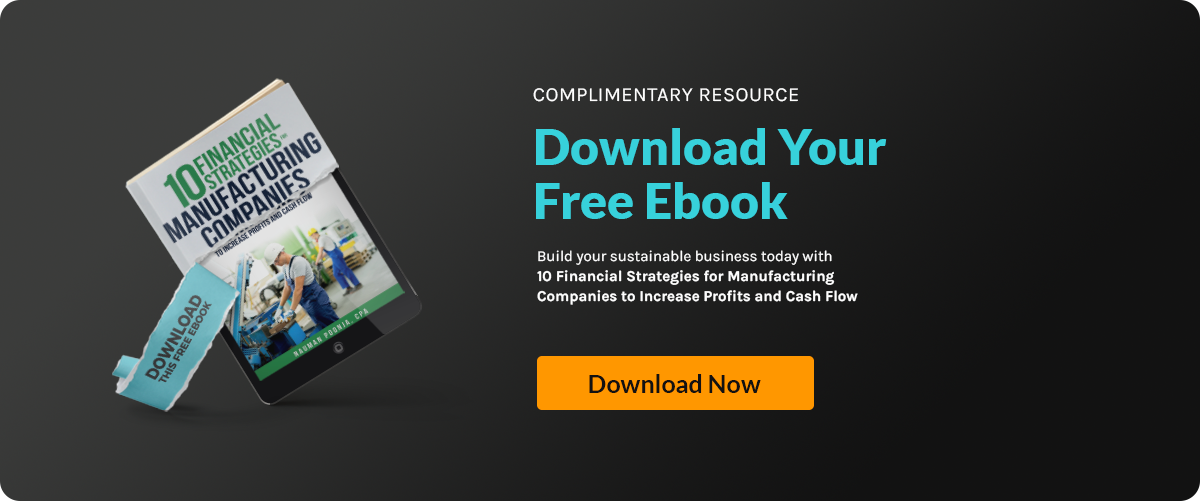When it comes to financial analysis, revenue is just the beginning. To get a clearer picture of...
What is GAAP and Why is it Needed?

If you run a manufacturing business, you’ve probably heard the term GAAP thrown around during audits, financial meetings, or when working with your accountant. But what exactly is GAAP, and why should it matter to your business?
In this blog, we’ll break down what GAAP is in plain language, explain its impact on financial reporting, and show how manufacturers benefit from using GAAP—especially as they grow, seek outside investment, or prepare for audits. Whether you’re a small machine shop or a multi-state manufacturer, understanding GAAP isn’t just good practice—it’s good business.
What Does GAAP Stand For?
GAAP stands for Generally Accepted Accounting Principles. These are the standard guidelines, rules, and frameworks used to prepare and present financial statements in the United States. GAAP ensures that all financial reports—whether from a Fortune 500 company or a local manufacturer—are:
- Consistent
- Comparable
- Transparent
- Reliable
GAAP is issued and maintained by the Financial Accounting Standards Board (FASB) and used by public companies, private entities, and nonprofits across the U.S. Its primary role is to create a level playing field for anyone interpreting financial reports.
For manufacturers, especially those dealing with complex supply chains, equipment investments, and inventory cycles, GAAP provides structure and clarity in financial reporting.
Why Is GAAP Important for Manufacturing Companies?
GAAP (Generally Accepted Accounting Principles) isn’t just a rulebook for accountants—it plays a direct and powerful role in how manufacturing companies operate, grow, and make financial decisions. Following GAAP helps ensure that your financial records are accurate, consistent, and trusted by others. Here’s how that matters in real life:
Profitability Analysis
Manufacturing businesses often deal with complex cost structures, including materials, labor, overhead, and equipment depreciation. GAAP helps break all of this down in a clear, standardized way so you can understand where your money is really going—and where you’re making or losing profit. It separates direct costs (like raw materials) from indirect costs (like factory rent) so you can make better pricing, budgeting, and production decisions.
Loan and Financing Options
Banks and other lenders need to trust your financials before giving you a loan. When you follow GAAP, your income statement, balance sheet, and cash flow statement are all formatted in a way that lenders recognize and rely on. This can improve your chances of getting approved for financing or securing better interest rates, especially when funding new machinery or expanding your facility.
Valuation for Investors
If you’re thinking about attracting outside investors or even selling your business one day, GAAP is critical. Investors want financial transparency. GAAP provides that by giving a full and accurate picture of how your company is performing. It helps them compare your company with others in the industry on a level playing field—because everyone is following the same accounting rules.
Audit Preparedness
No one enjoys going through a financial audit—but following GAAP can make the process smoother and less stressful. Auditors are trained to look for specific financial details laid out by GAAP. If your records follow those guidelines, it’s easier to pass an audit without delays, questions, or adjustments that could raise red flags with tax authorities or partners.
Strategic Planning and Forecasting
GAAP doesn’t just help with looking at the past—it also helps you plan for the future. Because it ensures that your financial data is consistent and reliable, you can use it to build more accurate budgets and forecasts. Whether you're planning next year’s hiring, budgeting for new technology, or trying to lower costs, GAAP gives you a strong foundation to base those plans on.
Real-World Example:
Imagine you invest $300,000 in machinery. Under GAAP, this isn’t an immediate expense. Instead, it’s capitalized and depreciated over time. That means your income statement won’t take a $300K hit in one year, offering a more accurate view of profitability. This approach aligns your financials with how the equipment generates value over time.
Without GAAP, that same $300K could distort your bottom line, making the company appear less profitable than it really is.
GAAP also helps manufacturers:
- Manage inventory costs with proper valuation methods
- Recognize revenue accurately based on delivery and production timelines
- Comply with tax and legal obligations
Key Principles of GAAP Explained
Here are some of the core GAAP principles and how they apply to manufacturing:
1. Accrual Accounting
Unlike cash-based accounting (which records money when it changes hands), accrual accounting recognizes income when earned and expenses when incurred. This is particularly important for manufacturers with large contracts, work-in-progress items, or deferred payments.
Read our Complete Guide to Accrual Accounting for Manufacturers for a deeper dive.
2. Revenue Recognition Principle
Revenue is recognized when it is earned—not necessarily when payment is received. If you ship products in December but receive payment in January, GAAP requires that the revenue be booked in December.
This is critical for accurate forecasting and aligning operating income and EBITDA with actual business activity.
3. Consistency Principle
Once you adopt a method—such as First-In-First-Out (FIFO) for inventory—you need to stick with it unless there’s a valid reason to change. This helps ensure financial data can be compared across reporting periods.
4. Materiality
Only transactions that significantly affect financial decisions need to be reported. For manufacturers, materiality might depend on production size, asset value, or revenue thresholds.
5. Matching Principle
Expenses should be recognized in the same period as the revenues they helped generate. For example, if you buy raw materials in June for a project you complete in August, the costs should be matched to August.
This alignment helps improve margin analysis and profitability tracking.
Does GAAP Apply to All Manufacturing Companies?
Short Answer: Not always. But it’s still smart to use it.
Private manufacturers may not be legally required to follow GAAP unless:
- They’re seeking funding or loans from banks
- They’re going public or preparing for sale
- They’re being audited
Even if not legally required, following GAAP:
- Makes your financials credible
- Gives you better control over performance
- Supports future growth and investment
Using GAAP also makes it easier to work with fractional CFOs, lenders, or private equity firms who expect standardized reports.
GAAP vs. Cash Accounting vs. IFRS
Here’s how GAAP compares to other popular accounting methods:
|
Feature |
GAAP |
Cash Accounting |
IFRS |
|
Recognition |
Accrual |
When cash changes hands |
Accrual |
|
Standardized? |
Yes (U.S.) |
No |
Yes (International) |
|
Preferred by investors |
✅ |
❌ |
✅ |
|
Ideal for Manufacturers? |
✅ |
❌ |
Maybe (for global ops) |
How GAAP Supports Business Growth
A GAAP-compliant financial system helps manufacturers:
- Make confident capital investment decisions
- Manage cash flow with greater precision
- Improve performance metrics like return on invested capital
- Simplify due diligence for M&A or succession planning
In other words, GAAP isn't just for the IRS—it's for your own business clarity.
GAAP and Your Internal Financial Team
When your internal team follows GAAP principles, they:
- Provide accurate monthly financials
- Catch issues early (e.g., inventory write-downs, asset impairments)
- Reduce friction with auditors or external advisors
That’s why many manufacturers upgrade their accounting processes or hire a fractional controller to implement GAAP-based systems.
Also consider incorporating GAAP into your manufacturing budget strategy to improve your forecasting and long-term financial visibility.
The Risks of Not Following GAAP
Manufacturers who ignore GAAP may face:
- Inaccurate cost reporting
- Failed audits
- Difficulty getting financing
- Legal and tax penalties
More importantly, they lack the ability to measure what really matters—from gross margins to return on capital—accurately. This reduces strategic flexibility and damages credibility.
If you’re not tracking your finances according to GAAP, you may also be misclassifying costs that affect pricing, production schedules, and profitability. That’s where we often see common problems in manufacturing finance arise.
Final Thoughts: GAAP = Growth, Accountability, Accuracy, and Planning
GAAP gives manufacturing businesses more than just financial clarity—it builds trust with lenders, improves operations, and supports scalable growth. It’s not always required, but it’s always beneficial.
By aligning with GAAP, your team gains a reliable roadmap for making informed decisions and steering your business through change.
Partner with Accounovation for GAAP-Compliant Success
At Accounovation, we specialize in helping manufacturers integrate GAAP into their operations—whether you need full financial oversight or just help aligning your reports with best practices. Our team of seasoned finance professionals works with you to simplify compliance, uncover savings, and support your company’s goals.
Let us help you build a smarter, GAAP-compliant accounting system that grows with your business. Contact Accounovation today to get started.







